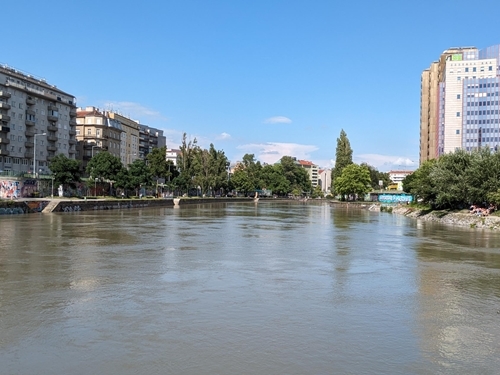By Prof. Chris Stoate, Allerton Project Head of Research
I recently returned from the biennial EURAF European Agroforestry Conference in the Czech Republic. My train from Vienna was cancelled because of exceptionally severe flooding in Austria and southern Germany so that I arrived home a day late. It was a relatively minor inconvenience. The flooding resulted in fatalities, river levels rising to their highest level in a century, and the Danube being closed to shipping.

Flood risk management is one of the research areas for the Allerton Project and its research partners in our Water Friendly Farming Project. Our research shows that simple permeable timber dams in the 1,000-hectare headwater of the Eye Brook can reduce peak flow by 15% in one in two-year storm events. For more intense storm events, the benefits are much reduced, and in the storms of the recent winter, which were estimated to be equivalent to around one in 40 or 50-year events, some of the dams were damaged. Given that such intense storms are becoming more frequent, this highlights the limit to which we can protect ourselves from the impacts of climate change.
Managing the wider landscape by improving soil management to increase the rate at which water permeates the ground, reducing surface runoff, is an additional approach to managing flood risk. If managed appropriately, grassland has an important role here. Our research shows that even a simple beetle bank of coarse grasses planted across a slope can increase water infiltration rates by up to nine times. But when the soil is completely saturated, infiltration and runoff cannot be controlled. That was the case through most of the recent winter. Again, there is a limit to which we can take measures to protect ourselves from the impacts of climate change. The priority must be to address climate change itself.
At the recent agroforestry conference, I presented the results of our research into reducing greenhouse gas emissions from ruminant livestock. Initial results suggest that feeding willow leaves to weaned lambs halves nitrous oxide emissions from their urine. In the scale of things, that may be a modest contribution to addressing climate change, but given that the global warming potential of nitrous oxide is nearly 300 times that of carbon dioxide, using willow as supplementary fodder appears to have a part to play.
Such integration of trees into farming systems, complementing rather than competing with food production, is very different from large scale afforestation of farmland. That is something that is increasingly carried out in the name of climate change mitigation, but in reality, results in long-term loss of productive land, often to justify the continued use of fossil fuels.
One shocking realisation of my attendance at the conference was that many delegates had flown in from other countries when they could have taken a train, reducing their climate impact. However positive our public environmental credibility may be, the science is clear that we are part of the problem rather than the solution if we continue to promote fossil fuel use by flying or holding pension funds and other investments in fossil fuels.
Meanwhile, in the flooded areas of Austria and Germany, the results of the European election reveal a swing to the right, largely influenced by popular concerns about immigration, a process that is increasingly influenced by climate change impacts elsewhere in the world. The tragic irony is that the change in governance may result in a relaxation of political determination to address climate change.
Now that the predicted implications of the UK’s departure from the EU have become reality, one possible positive consequence may be that our new government from July can take a lead in implementing measures that address both climate change adaptation and mitigation. Allerton Project research can contribute to that process.